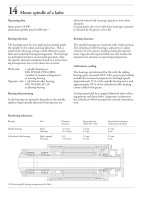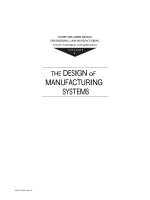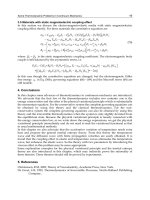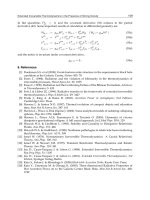The Design of Manufacturing Systems Part 6 ppt
Bạn đang xem bản rút gọn của tài liệu. Xem và tải ngay bản đầy đủ của tài liệu tại đây (108.97 KB, 2 trang )
the coverability of the safe space S
s
by the policy-admissible subspace, S(P). More formally, consider the
polynomial-kernel policy defined by property H and let that is,
the policy admissible subspace. Then, a viable policy efficiency measure is provided by the ratio
(4.12)
where denotes the cardinality number of set S.
Because of the typically large size of the S(H) and S
s
subspaces, their explicit enumeration will not be
possible and, therefore, we must resolve simulation and statistical sampling techniques. Such a technique,
known as the co-space simulation technique, is developed in Reference [62]. Briefly, this approach recog-
nizes that the set of safe states of a given SU-RAS, Q corresponds to the reachability set of a “co-system,”
QЈ, which is defined from the original RAS Q by reversing its job routes. Hence, the operation of the co-
system QЈ is simulated until a sufficiently large sample of states is obtained. According to the previous
remark, this sample set consists of safe states of the original system. In continuation, the condition H
defining the evaluated DAP is applied on the extracted sample set and the portion of the sample states
admitted by the policy is determined. This portion expresses the policy coverability of the extracted sample
set, and constitutes a point estimate for index I. Application of this technique to the polynomial-kernel
DAPs of Section 4.5, and experimental evaluation results can be found in References [58], [59], and [62].
In the rest of this section, we discuss some properties of polynomial-kernel DAPs which can be used to
enhance the operational flexibility of these policies when implemented on any given FMS configuration.
Policy Disjunctions and Essential Difference
The first way to improve the efficiency of an FMS structural controller employing polynomial-kernel
DAPs, with respect to the metric of Eq. (4.12) is based on the following proposition.
Proposition 4.4 Given two conditions H
1
( ) and H
2
( ) defining correct polynomial-kernel DAPs, the policy
defined by the disjunction H
1
( ) H
2
( ) is another correct polynomial-kernel DAP.
To see this, simply notice that acceptance of a state s by the policy disjunction implies that at least one of
the two policy defining conditions, H
1
( ), H
2
( ), evaluates to TRUE at s and, therefore, state s is safe. Further-
more, if state s ʦ S(H
i
), i ʦ {1, 2}, then the correctness of the corresponding policy implies the existence of
at least one feasible event e, which is enabled by that policy, and
␦
(e, s) sЈ ʦ S(H
i
) (cf. Theorem 4.2). Then,
sЈ ʦ S (H
1
H
2
), and according to Theorem 4.2, the policy defined by H
1
( ) H
2
( ) is correct.
It is also easy to see that the subspace admitted by the policy disjunction is the union of the subspaces
admitted by the two constituent policies. If it happens that
(4.13)
then S(H
1
) S(H
2
) is richer in states than any of its constituents. Therefore, the resulting policy is more
efficient with respect to index I.
Two polynomial-kernel policies based on conditions H
1
and H
2
that satisfy Eq. (4.13) are characterized
as essentially different. The essential difference of the polynomial-kernel policies presented in Section
4.5 is analyzed in Reference [59]. It turns out that RUN and the FMS Banker’s algorithm are essentially
different, while RO is subsumed by Banker’s.
Optimal and Orthogonal Orderings for RUN and RO DAPs
A second opportunity for improving the efficiency of RUN and RO DAPs is provided by the fact that the
defining logic of these two policies essentially leads to entire families of policies for a given FMS configu-
ration. As we saw in Section 4.5, each member of these families is defined by a distinct ordering of the
system resource set. Hence, a naturally arising question is which of these orderings leads to the most efficient
SH() s
i
S : ʦ H(s
i
) is TRUE{},ϵ
I
SH()
S
s
ϭ
S
∨
ϵ
∨∨
SH
1
() SH
2
()()SH
2
() SH
1
()()∧
ʜ
© 2001 by CRC Press LLC
5
The Design of
Human-Centered
Manufacturing Systems
5.1 Introduction
5.2 Concept, Implementation, and Evaluation
of Human-Centered Systems
The Concept of Human-Centered Systems • Human-Centered
Systems in Practice: Some Observations • Designing and
Evaluating Human-Centered Systems • Simulation as an
Evaluation Strategy
5.3 Shop Floor Control: NC Technology for Machining
of Complex Shapes
The Scope of the MATRAS Project • NC Kernel Improvement
• A New NC Programming Data Interface • Conclusions
5.4 Shop Floor Information Support: Developing
User-Oriented Shop Floor Software
The Concept of Shop Floor Software Development • The
Software System to Support Work Planning • The Software
Tool to Support Group Communication • Conclusion
5.5 Shop Floor Cooperation Networks: A Shop Floor
Production Planning System for Groupwork
The Need for Computer–Supported Cooperative Work
• Human-Centered CIM • Workflows for Shop Floor PPC
• Conclusions
5.6 Process Control: Human-Process Communication
and Its Application to the Process Industry
The Concept of Human-Process Communication
• Characteristics of Operational Situations • Presenting
Human-Process Communication • Integration of Operational
Experience • Conclusions
5.7 Enterprise Networks: The Reengineering
of Complex Software Systems
Problems of Software Reengineering: The Example of a
Tourism Network • The Reengineering of a Tourism Booking
and Information Software System • The Methodological
Approach to the Software Reengineering Project • Conclusions
5.8 Assessing the Human Orientation of New Control
Technology: The Example of Slovenia
The Concept of Success Factors • The Importance of Human
Orientation as a Success Factor • How to Integrate New
Dietrich Brandt
University of Technology (RWTH)
Inga Tschiersch
University of Technology (RWTH)
Klaus Henning
University of Technology (RWTH)
© 2001 by CRC Press LLC









